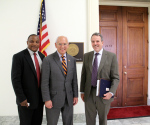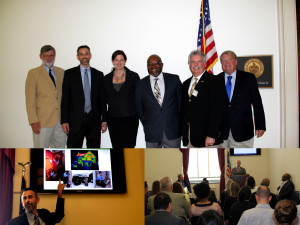
The Weatherization Assistance Program (WAP) is the fuel of the future. You know that. We know it. But not everyone in Congress has seen the light yet. Last Thursday, NASCSP staff once again headed up Capitol Hill to tell House of Representatives staffers about the benefits of weatherization technology and how WAP can turn things around for struggling households and businesses alike at a bipartisan briefing sponsored by Representatives Paul Tonko (D-NY) and David McKinley (R-WV).
“Energy efficiency should be our fuel of choice,” Representative Tonko told the gathering. He wants his fellow legislators to understand how important programs like WAP are to our national security by reducing dependence on fossil fuels.
We also want Representatives and Staffers to see that WAP brings real bottom-line benefits to their districts. So, we brought along a panel of experts from all over the country with powerful stories to tell of the immediate impact WAP has on families, companies, communities, and local economies:
- Rod Williams, founder and owner of Energy Savers, Inc. gave a brief history of his Washington State-based company and told how WAP had allowed him to create and retain jobs during difficult times.
- Rich Courtney, long-time weatherization professional from LTI, Inc., brought the group up to date on technological developments. He demonstrated how a hand-held infrared camera can expose hidden insulation gaps and air penetrations. He related a typical example from Congressman McKinley’s district in which a WAP auditor found excessively high levels of carbon monoxide from a badly cracked heat exchanger in the furnace of an elderly woman’s trailer home. The WAP crew repaired the furnace, likely saving her life and allowing her to afford to continue living independently.
- Mark Jackson from the New River Center for Energy Research and Technology (NRCERT) told about his work training WAP technicians from around the country at a state of the art facility in Virginia. He explained how WAP’s “whole house” approach not only improves energy efficiency, but also promotes health and safety at the same time.
- Frank Spevak from The Energy Conservatory related how the blower door revolutionized home energy audits. He noted that the Recovery Act helped his business to survive and had a positive impact on his city as his orders for materials rippled through the local economy.
- Marci DeVries told how her company, Hawkeye Construction, got into the Weatherization business during the Recovery Act and how the funding from Maryland allowed the company to keep employees working through the economic downturn. Hawkeye Construction has since expanded to include even more services and has managed to retain its employees through the economic downturn.
A big thank you to these industry leaders for taking the time to help us tell Congress what really works. For more details on their presentations, check out their slides here. For that extra dash of “you are there” realism, look at the event photos on our Facebook page.






